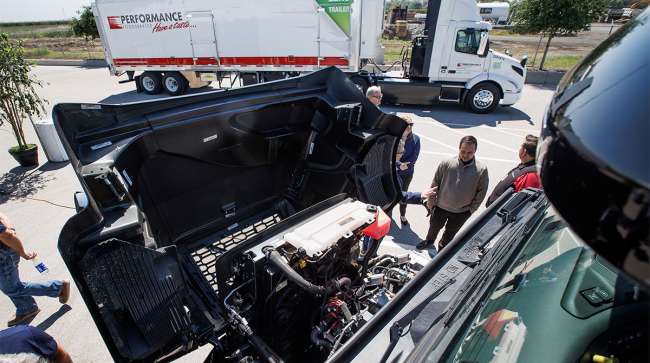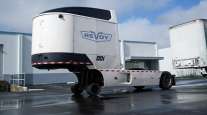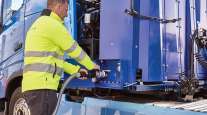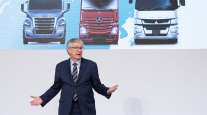The Mercury News
Performance Food Group Takes Electric Plunge

[Stay on top of transportation news: Get TTNews in your inbox.]
On a recent cloudless spring day on the outskirts of Gilroy, Calif., Christian Martorella accelerated an 18-wheeler past budding orchards. But instead of the roar of a diesel engine, the cab filled with the gentle hum of an electric motor.
After driving diesel trucks for 10 years, Martorella initially eyed electric trucks skeptically. Now, he has nothing but praise for the cutting-edge machines, which he says ride smoother, accelerate faster, and are all around easier to maintain.
“It’s crazy how consistent that they’ve been,” he said. “(They) definitely knocked it out of the park.”
The truck is one of seven heavy-duty electric trucks deployed to haul food at Performance Food Group in Gilroy, supported by an array of brand new charging stations, an upcoming installation of solar panels and a fleet of all-electric refrigerated trailers.
Performance Food Group ranks No. 5 on the Transport Topics Top 100 list of the largest private carriers in North America, and No. 3 on the food service list.
While the Gilroy site is one of only a handful across the country experimenting with the emissions-free tech for semis, state regulations will push more and more trucks in that direction in the coming years. By 2036, manufacturers will only be able to sell zero emissions heavy-duty trucks in California, and many fleets will gradually be required to incorporate more zero emission vehicles over the next decade.
“It’s important for anyone in their business to be thinking about these things. But they are out ahead of the curve,” Bill Robertson, vehicle program specialist for California Air Resources Board. “We’re pretty excited about what they’re doing there.”

Williamson
The Gilroy site will serve as a test bed for the new technologies — both for the company and the industry — allowing them to understand the strengths and limitations of the tech in the real world. “We’ll continue to learn from this and add other technologies to it,” said Jeff Williamson, senior vice president of operations for Performance Food Group. “This is somewhat of our flagship, our model that we intend to build facilities on as we go forward.”
Historically, trucking and shipping have been far from green. According to the Environmental Protection Agency, transportation makes up about 29% of greenhouse gas emissions in the U.S., and about a quarter of that comes from the medium- and heavy-duty trucks that drive industry and lug freight across the country. Almost all of those trucks run on diesel, a fuel with emissions that are associated with health risks such as asthma, and heart and lung disease.
“Diesel’s been a great fuel for us. We just didn’t realize 75 years ago that it was gonna kill the planet,” said Mike Roeth, executive director of the North American Council for Freight Efficiency. “Now we’ve got to do something different.”
But doing “something different” is hard, especially for big rigs. Only 0.02% of the more than 5 million heavy-duty trucks in the U.S. are zero emission, according Calstart, an organization that researches clean transportation. And switching over more of those trucks to electric comes with some serious hurdles.
To start, the electric trucks have a limited range. The trucks used in Gilroy reach about 200 miles per charge. Their batteries are also heavy, which means that electric trucks can come up against weight limits on roads, triggering potential trade-offs between energy and precious cargo.

Roeth
Heavy-duty chargers for the batteries are also scarce, and often, relatively slow. Even rapid chargers can take 45 minutes to charge compared to the 10 minutes it may take to fill a tank with fuel. The batteries also require a lot of power to charge — each truck is the equivalent of about four to six Teslas, in terms of power, so larger truck stops and depots could need serious upgrades to their grids in order to provide what Roeth calls “a football stadium’s worth of power” to the trucks’ batteries.
“In today’s world, there is no battery-electric vehicle that can truly replace, mile for mile, the capabilities that you get from a diesel engine vehicle,” said Len Lamkin, vice president of transportation logistics for Performance Food Group
At its pilot site in Gilroy, Performance Food Group is working to change that. The company ships food to thousands of locations across the country, and the Gilroy warehouse serves much of Northern California and beyond. Two of its current electric trucks have been running routes to Santa Cruz since last year. The company also just expanded its electric fleet to seven by adding new electric trucks made by Volvo that will be deployed for deliveries throughout the region.
Check out Transport Topics' updated Top 100 list of the largest logistics companies in North America, and explore how the industry's top players have adapted to a tough freight market and are preparing for the future. Tune in above or by going to RoadSigns.ttnews.com.
This progress has been made possible by a new set of chargers from the company FreeWire Technologies, which are capable of powering the electric fleet. Each charger is equipped with an internal battery, which allows the charger to store up power over time when demand is low. Then, they can deliver the electricity to the trucks when they come in to charge without needing to pull energy from the grid all at once.
The charging setup is one of the largest for heavy-duty trucking in the nation, says David Hochschild, chair of the California Energy Commission. And by using the chargers with batteries inside, the site didn’t need to make upgrades to the grid, which would be expensive and could take years. The upcoming solar array also helps offset the expected increase in energy demand that would accompany an expanding electric fleet.
“This is really a postcard from the future,” said Hochschild.
Since the company specializes in food delivery, they are also piloting a fleet of over 30 electric refrigerated trailers. While most refrigerated trailers keep cool using a diesel-powered engine, the electric unit uses a battery. The trailer is also equipped with regenerative braking and solar roofs — which means that on hot, sunny days when keeping things cool requires more energy, it benefits from extra solar power. According to Advanced Energy Machines, which designs and manufactures the units, switching each trailer saves about 20 metric tons of carbon dioxide emissions a year — roughly equivalent to taking four passenger cars off the road.
Want more news? Listen to today's daily briefing above or go here for more info
All of this new technology comes at a cost, however. An electric 18-wheeler can sell for $365,000 to $435,000, more than twice the $170,000 price tag of a typical diesel truck, according to TEC equipment, which sold the trucks. Some $120,000 per truck is offset by a state grant, and the site expects to recuperate much of the up-front cost in savings from maintenance and diesel fuel.
In the end, the electric trucks will likely be part of a multipronged approach that uses different technologies for different applications. The battery-powered cabs could be used over shorter distances where range is less of a concern, while other technologies, such as hydrogen-powered vehicles, might be more suitable for longhaul trucks.
“There’s not just one application that’s going to fit all … there’s no silver bullet,” said Williamson. “It’s going to be a mix, we believe, of various technologies. We’re just trying to home in on the right mix.”
Distributed by Tribune Content Agency, LLC





